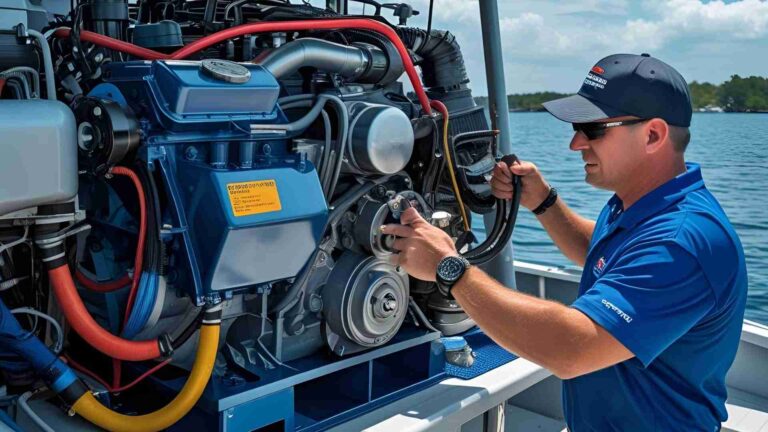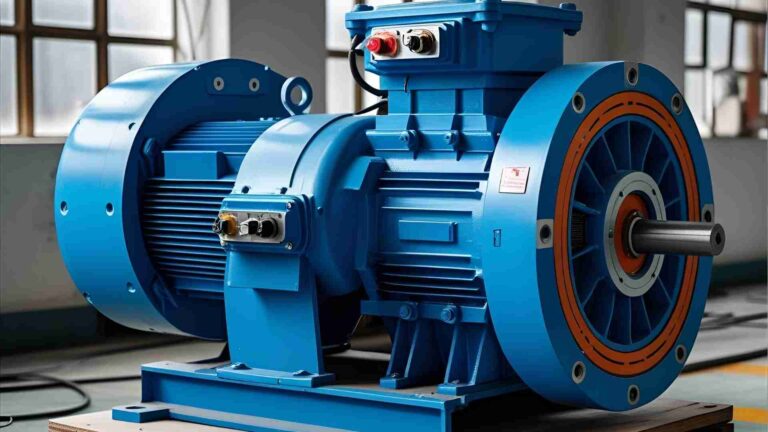Marine Machinery – Heat Transfer and Thermofluid Systems
Explore marine machinery’s heat transfer & thermofluid systems, covering thermodynamics, fluid mechanics, hydraulics, and their ship applications.
Marine engineering relies on the intricate interplay of thermodynamics, heat transfer, fluid mechanics, and hydraulics to ensure ships operate efficiently and reliably. These disciplines underpin the design and functionality of propulsion systems, auxiliary machinery, and various onboard systems critical to maritime operations. This article delves into these core areas, their applications in marine machinery, and the challenges students face in mastering them, providing a comprehensive guide for engineers, students, and enthusiasts.
Thermodynamics in Marine Engineering
Thermodynamics is the science of energy and its transformations, forming the backbone of marine propulsion and auxiliary systems. It governs how energy is converted into work in systems like diesel engines, steam turbines, refrigeration units, and HVAC systems on ships.
Key Concepts
- Energy Conservation: The first law of thermodynamics ensures that energy within a system is conserved, guiding the design of efficient propulsion plants.
- Entropy and Enthalpy: These measure disorder and total energy, respectively, helping engineers assess system inefficiencies.
- Exergy: This quantifies the useful work potential, critical for optimizing energy use in marine systems.
- Thermodynamic Cycles: The Rankine cycle powers steam turbines, while the Brayton cycle drives gas turbines. Refrigeration cycles ensure perishable cargo stays fresh.
Applications
Thermodynamics is applied in analyzing engine performance, calculating fuel efficiency, and minimizing energy losses. For instance, in a diesel engine, engineers use thermodynamic principles to optimize combustion, ensuring maximum power output with minimal fuel consumption. According to industry insights, marine diesel engines achieve thermal efficiencies of 40-50%, with advanced designs pushing these limits.
Challenges for Students
Students often struggle with thermodynamics due to its abstract concepts, such as entropy and enthalpy, which are not intuitive. Unlike calculus, where problems have clear solutions, thermodynamics requires understanding system states (e.g., steady-state or reversible processes) and selecting appropriate equations. Social media discussions on platforms like Reddit highlight that problems can take hours to solve, especially in advanced courses, due to the need to interpret complex scenarios and apply multiple concepts simultaneously.
| Thermodynamic Concept | Marine Application | Key Challenge |
|---|---|---|
| Entropy | Engine efficiency analysis | Understanding non-intuitive behavior |
| Enthalpy | Combustion calculations | Relating to system performance |
| Exergy | Energy optimization | Complex calculations |
Heat Transfer in Marine Machinery
Heat transfer studies how thermal energy moves due to temperature differences, a critical aspect of marine machinery design. It ensures components like boilers, heat exchangers, and propellers operate within safe thermal limits.
Modes of Heat Transfer
- Conduction: Heat flow through solids, such as engine blocks.
- Convection: Heat transfer via fluid motion, critical in cooling systems.
- Radiation: Heat emitted as electromagnetic waves, less common but relevant in high-temperature exhaust systems.
Applications
Heat exchangers are vital in marine systems, transferring heat between fluids to cool engines or heat water. For example, plate heat exchangers are used in main engine cooling systems, with efficiencies reaching 90% in modern designs. Thermal stress management in materials prevents component failure, while optimizing heat transfer enhances system performance.
Challenges for Students
Heat transfer involves complex calculations, often requiring multivariable calculus for advanced scenarios like transient heat conduction. Students find it challenging to select the right heat transfer mode for a problem and apply boundary conditions correctly. Online forums note that heat transfer courses demand a strong grasp of foundational math, with errors in algebra or calculus compounding mistakes.

Fluid Mechanics in Ship Design
Fluid mechanics explores how liquids and gases behave, crucial for understanding ship hydrodynamics and internal fluid systems.
Fundamental Principles
- Conservation Laws: Mass, momentum, and energy conservation govern fluid flow.
- Viscosity and Pressure: These dictate fluid resistance and flow behavior.
- Bernoulli’s Principle: Relates pressure, velocity, and elevation in fluid flow, key for propulsion design.
Applications
Fluid mechanics informs hull design to minimize resistance, propeller design for efficient thrust, and piping systems for fuel and water transport. For instance, computational fluid dynamics (CFD) simulations optimize hull shapes, reducing drag by up to 15% in modern vessels.
Challenges for Students
Fluid mechanics is notorious for its applicational complexity. Students must interpret problems to identify relevant principles, such as whether viscous losses are significant or if a flow is laminar or turbulent. Reddit users emphasize that fluid mechanics demands mastery of concepts like boundary conditions and streamline analysis, with differential equations adding mathematical rigor.
| Fluid Mechanics Topic | Marine Application | Mathematical Tool |
|---|---|---|
| Bernoulli’s Equation | Propeller thrust | Algebra, Calculus |
| Navier-Stokes Equations | Hull drag analysis | Differential Equations |
| Viscosity | Piping system design | Multivariable Calculus |
Hydraulics in Maritime Systems
Hydraulics focuses on liquid-based power transmission, essential for shipboard systems like steering gears, cranes, and cargo handling equipment.
Key Concepts
- Pressure and Flow Rate: Determine hydraulic system performance.
- Hydraulic Power: Calculated as pressure times flow rate, powering machinery like winches.
- Pascal’s Principle: Ensures uniform pressure transmission in confined fluids.
Applications
Hydraulic systems drive steering gears, ensuring precise ship maneuverability. For example, a typical hydraulic steering system for a container ship operates at pressures of 100-200 bar, delivering reliable control. Deck cranes, vital for cargo handling, rely on hydraulics for lifting capacities up to 50 tons in standard marine applications.
Challenges for Students
Hydraulics problems often involve practical applications of fluid mechanics, requiring students to translate theoretical knowledge into real-world systems. The math is less intensive, focusing on algebra and basic calculus, but understanding system dynamics and component interactions is critical.

Interconnections in Marine Systems
These disciplines are deeply interconnected in marine engineering. For example:
- A diesel engine’s cooling system requires thermodynamics to calculate heat rejection, heat transfer for exchanger design, fluid mechanics for coolant flow, and hydraulics for pump operation.
- Propeller design integrates fluid mechanics for thrust, thermodynamics for engine efficiency, and heat transfer for cooling.
This interconnectedness makes marine engineering challenging but rewarding, as engineers must synthesize multiple disciplines to solve problems.
Why Are These Disciplines Challenging?
Students frequently discuss the difficulty of thermodynamics, heat transfer, fluid mechanics, and hydraulics on platforms like Reddit’s r/EngineeringStudents. Common pain points include:
- Conceptual Complexity: Concepts like entropy, enthalpy, and streamline analysis are abstract and require deep understanding, not just memorization. One user noted that thermodynamics problems can take hours due to the need to interpret system states and select appropriate equations.
- Mathematical Rigor: While basic thermodynamics uses algebra, advanced topics involve multivariable calculus and differential equations. Fluid mechanics often requires solving Navier-Stokes equations, which are notoriously complex.
- Problem Interpretation: Unlike straightforward math problems, these courses demand identifying relevant principles and making assumptions (e.g., steady-state or insulated systems). A user emphasized that fluid mechanics requires “mastery” to navigate assumptions correctly.
- Time-Intensive Problems: Exams often feature lengthy problems, with some taking over an hour, as noted by a mechanical engineering graduate. Mistakes in early steps can derail entire solutions.
- Teaching Quality: Poor instructors exacerbate difficulties, as seen in complaints about professors who fail to clarify concepts or structure courses poorly.
Strategies for Success
- Work Backwards: Start with the desired outcome and identify required formulas, as suggested by multiple users.
- Understand Concepts: Avoid rote memorization; focus on why equations apply to specific scenarios.
- Practice Consistently: Dedicate regular study time to build intuition, as one student’s semester-long study plan led to top grades.
- Use Resources: Tools like WolframAlpha, Khan Academy, and MIT OpenCourseware can clarify concepts.
- Check Units: Ensure unit consistency to avoid errors, a tip echoed by tutors and students.
Specifications and Costs
Marine machinery varies widely in specifications and cost, depending on application:
| Component | Specification | Approx. Cost (USD) |
|---|---|---|
| Marine Diesel Engine | 5,000-20,000 kW, 40-50% efficiency | $1M-$10M |
| Plate Heat Exchanger | 90% efficiency, 100-500 m² surface | $10,000-$100,000 |
| Hydraulic Steering | 100-200 bar, 50-100 kN torque | $50,000-$200,000 |
| Propeller | 2-10 m diameter, 60-80% efficiency | $100,000-$1M |
Note: Costs vary based on ship size, manufacturer, and customization. For precise pricing, consult suppliers like Wärtsilä or MAN Energy Solutions.
Conclusion
Thermodynamics, heat transfer, fluid mechanics, and hydraulics are the pillars of marine machinery, enabling efficient and reliable ship operations. These disciplines, while challenging, are manageable with consistent study, conceptual understanding, and strategic problem-solving. By mastering these areas, engineers and students can design and operate advanced marine systems, contributing to the maritime industry’s innovation and sustainability.
Happy Boating!
Share Marine Machinery – Heat Transfer and Thermofluid Systems with your friends and leave a comment below with your thoughts.
Read Marine Diesel Engine Maintenance Schedule until we meet in the next article.





